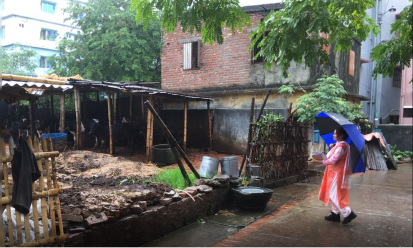My project focused on developing a methodology for spatially representing sanitation systems in unsewered cities in the global south. I have spent three weeks over the months of July and August 2022 doing fieldwork to validate a prototype developed using open-source data for a small area of Rajshahi city in northwest Bangladesh. The sole sanitation system in this city is comprised of individually controlled and maintained onsite septic tanks and pits.

The aim of the fieldwork was to find out how effective the methodology is at mapping faecal matter sources and their movement. The informal usage of the city’s storm drainage network is the way of supernatant fluid movement; in some situations or in certain portions (older part) of the city, faecal solids are also carried out of the city via those drains.
Direct observation was the most important aspect of this fieldwork, along with unstructured interviews and discussion with the city authorities and sanitation experts. I did direct observations at 60 different places where preset sanitation parameters, such as septic tank connection to drain, drainage flow direction, drain width, and overflow area, were seen. The city officials do not monitor sanitary facilities or collect important data, such as whose households employ emptying services and who has the required soak pit. The observations made of the drainage network and the direction of faecal movement, which are typically gravity-driven open channel flows, largely (>80%) corresponded with the forecasts made by the methodology using freely-available open source data, which was an intriguing finding.

Through observation, discussion, and informal conversations with locals, it appears that the drains are maintained as and when necessary by the city corporation. Drain cleaning occurs at a particular location when residents request to the word commissioner but it is not the planned cleaning for the entire street or drain, so it does not last for very long. The other aspect, which is striking, is that after a rain shower, the drainage network can’t keep up and is flooded. Given that the open drains are being used for the purpose of transporting septic tank effluent and are sometimes full of faecal sludge, it is reasonable to assume that people are exposed to faecal contamination wherever they are exposed to flood water. Such exposures are normal for street users and in some cases properties are flooded too.
